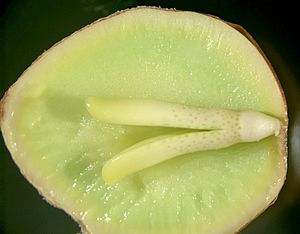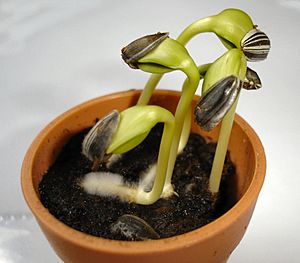Seed facts for kids
A seed is a tiny package from a plant that can grow into a brand-new plant! It's like a special container that protects a baby plant and gives it food until it's ready to sprout. Every seed has three main parts:
- A tiny embryo (the baby plant).
- A supply of nutrients (food) for the embryo.
- A protective seed coat.
There are so many different kinds of seeds! Some plants make tons of tiny seeds, while others make just a few big ones. Seeds are often hard and very small, but some, like the coconut, are huge! When seeds are first formed, they are usually dormant, which means they are resting inside their coat. When a seed is ready to grow, it needs water, air, and warmth. It does not need sunlight to start growing into a seedling.
Seeds carry the food that helps the new plant begin to grow. This food is stored in a part called the endosperm or in special leaves called cotyledons. Many seeds are important food for animals and people. Think of rice, wheat, and maize (corn) – these are all seeds that we eat! Seeds are often found inside fruits.
Contents
How Seeds Are Made
Seeds from flowering plants (called angiosperms) grow inside a structure called a fruit. This fruit can be hard or soft and fleshy, and it protects the seeds as they develop. For example, an apple is a fruit that protects its seeds inside.
Other plants, like conifers (gymnosperms), don't have fruits. Their seeds start growing "naked" on the scales of cones. As the seeds grow, the cone scales usually cover them up for protection.
The number of seeds plants produce can change a lot each year. Things like weather, insects, and diseases can affect how many seeds a plant makes. Sometimes there are lots of seeds, and sometimes there are only a few.
Seed Development and Life Cycle
In flowering plants, seeds have three parts that come from different genetic sources:
- The embryo, which is the baby plant.
- The endosperm, which is the food supply.
- The seed coat, which comes from the mother plant's tissue.
Seed development starts after a process called double fertilization. This is when two male cells join with different parts of the plant's egg cell. One joining creates the embryo, and the other creates the endosperm. The endosperm grows quickly to provide food for the young plant until its roots can grow after germination.
Ovule
After fertilization, the ovules inside the plant's ovary develop into seeds. The ovule has several parts:
- The funicle (or seed stalk) connects the ovule to the plant's ovary wall.
- The nucellus is the main part of the ovule where the baby plant develops.
- The micropyle is a small opening where the pollen tube usually enters during fertilization.
- The chalaza is the base of the ovule.
The shape of the ovules often affects the final shape of the seeds.
Embryo

The embryo is the most important part of the seed because it's the actual baby plant. It has several key parts:
- The cotyledons are the seed leaves. Some plants, called monocots, have one cotyledon. Most other plants, called dicots, have two. These cotyledons can also store food for the embryo.
- The epicotyl is the part of the stem above the cotyledons.
- The plumule is the very tip of the epicotyl. It looks feathery and will grow into the plant's shoot (stem and leaves) when the seed sprouts.
- The hypocotyl is the part of the stem below the cotyledons. It connects the epicotyl to the root.
- The radicle is the very tip of the hypocotyl. It will grow into the plant's first root.
Seed Shape and Look

Seeds come in many different shapes and sizes. Some common shapes include:
- Bean-shaped (like a kidney bean).
- Square or Oblong (longer than wide).
- Triangular (three-sided).
- Elliptic or Ovate (rounded, like an egg).
- Discoid (like a disc or plate).
- Globose (spherical) or subglobose (almost spherical).
Most seeds are brown or black, but some can be other colors. Their surfaces can be smooth and shiny or rough. Some seeds even have special parts or textures on their coats.
Seed Structure
A typical seed has two main parts:
- An embryo (the baby plant).
- A seed coat (the protective outer layer).
Many seeds also have an endosperm, which is a supply of food for the embryo. This is especially true for monocots and some dicots.
Embryo
Inside the seed coat, there's the embryo, which is the young plant ready to grow. The embryo has one seed leaf (cotyledon) in monocots, two in most dicots, and sometimes more in gymnosperms.
Nutrient Storage
Seeds usually have a store of food for the seedling that will grow from the embryo. This food helps the young plant get a strong start before it can make its own food through photosynthesis.
Size and Number of Seeds
Seeds vary greatly in size. Orchid seeds are incredibly tiny, like dust, with about a million seeds in just one gram!
Plants that make smaller seeds can produce many more of them from each flower. Plants with larger seeds put more energy into each seed, so they usually make fewer. Small seeds ripen faster and can spread more quickly. Many annual plants (plants that live for one year) make lots of small seeds to make sure at least a few find a good place to grow.
Perennial plants (plants that live for many years) and woody plants often have larger seeds. These seeds have more food stored, which helps the seedling grow bigger and stronger right after it sprouts.
What Seeds Do
Seeds have several important jobs for the plants that make them:
- They feed the embryo.
- They help the plant spread to new places (this is called dispersal).
- They allow the plant to rest during bad conditions (this is called dormancy).
Seeds are also how most plants reproduce. They are usually the result of sexual reproduction, which mixes up genetic material and helps plants adapt to their environment.
Embryo Nourishment
Seeds protect and feed the baby plant inside. They give a seedling a much better start than a sporeling (a plant growing from a spore) because seeds have more food stored and a more developed embryo.
Dispersal
Plants can't move around like animals to find good places to live. So, they have developed many clever ways to spread their seeds. A seed needs to get to a good spot and be there at the right time to sprout and grow.
Spreading by Wind (Anemochory)

- Some seeds, like those from pine trees, have a wing that helps the wind carry them.
- The dust-like seeds of orchids are easily carried by the wind.
- Seeds from plants like milkweed or poplar have hairs that help them float on the wind.
- Dandelion seeds also have hairs that act like tiny parachutes.
- Maple seeds have two wings that make them spin like helicopters as they fall.
Spreading by Water (Hydrochory)
- Some plants, like Mucuna, make seeds that float. These are called sea-beans or drift seeds because they can float down rivers to the ocean and wash up on distant beaches.
Spreading by Animals (Zoochory)
- Some seeds have hooks or barbs (like burrs) that stick to animal fur or feathers. They then fall off somewhere else. Examples include acaena and burdock.
- Seeds with a fleshy covering, like those in apples, cherrys, or juniper berries, are eaten by animals (birds, mammals, reptiles, fish). The seeds pass through the animal's body and are dropped in their droppings, often far from the parent plant.
- Seeds that are tasty nuts (like acorns, hazelnuts, walnuts) are collected and stored by animals. If the animal forgets some of its stored seeds, those seeds might grow into new plants.
Myrmecochory is when seeds are spread by ants. These seeds have a special part called an elaiosome that ants like to eat. The ants carry the seeds to their nests, eat the elaiosome, and then discard the seed, helping it to spread. Examples include bloodroot and trilliums.
Dormancy

Seed dormancy means a seed is resting and won't sprout even if conditions are good. This is important for two reasons:
- It helps the seed wait for the best time to sprout, like when there's enough water and warmth.
- It helps spread out when seeds sprout over time. This way, if something bad happens (like a late frost or a drought), not all the baby plants will die at once.
Germination

Seed germination is the process where a seed's embryo starts to grow into a seedling. It involves the seed waking up and starting to grow its first root (the radicle) and shoot (the plumule). When the seedling pops up above the soil, it's called seedling establishment.
Three main things need to happen for a seed to germinate: 1. The embryo inside the seed must be alive (this is called seed viability). 2. Any dormancy that prevents sprouting must be overcome. 3. The environment must have the right conditions for growth (like proper temperature and moisture).
Germination happens in three steps: 1. The seed soaks up water (this is called imbibition), which makes it swell and split its seed coat. 2. There's a short resting period (lag phase). 3. The radicle (first root) emerges.
Why Seeds Are Important

Seeds are incredibly important to people and the economy.
Seed Market
In the United States, farmers spend billions of dollars on seeds each year. A few large companies sell most of the corn and soybean seeds.
Edible Seeds
Many seeds are edible, and they provide most of the food calories for humans! Think of cereals like rice and wheat, legumes like beans and lentils, and nuts like almonds and walnuts. Seeds also give us most cooking oils, many beverages (like coffee beans), spices, and some important food additives.
The food stored in seeds is found in the embryo or the endosperm. This stored food is full of proteins that are important for our diet. For example, the gluten in wheat, which makes bread dough stretchy, is a protein from the endosperm.
Seeds are used to grow many crops, including grains, beans, forest trees, and grasses for lawns and pastures. In many parts of the world, especially in developing countries, farmers often save seeds from their own crops to plant next year because it's hard to buy new seeds.
Seeds are also eaten by animals and are used as feed for livestock or as birdseed.
Other Uses
- Cotton fiber grows right on the seeds of the cotton plant. Other plants like kapok and milkweed also produce fibers from their seeds.
- Many important oils that we don't eat are taken from seeds. For example, linseed oil is used in paints. Oil from jojoba and crambe plants is similar to whale oil.
- Some medicines come from seeds, like castor oil.
- Many seeds have been used as beads for necklaces and rosaries, such as Job's tears and Chinaberry. But be careful, some seeds used as beads, like rosary pea and castor bean, are poisonous!
Other ways seeds are used:
- In the past, some seeds were used as weights on balances.
- Children sometimes use seeds as toys, like for the game Conkers.
- Resin from Clusia rosea seeds was used to seal boats.
- Nematicide (a substance that kills tiny worms) can be made from milkweed seeds.
- Cottonseed meal (what's left after oil is taken from cotton seeds) is used as animal feed and fertilizer.
Images for kids
See also
 In Spanish: Semilla para niños
In Spanish: Semilla para niños











